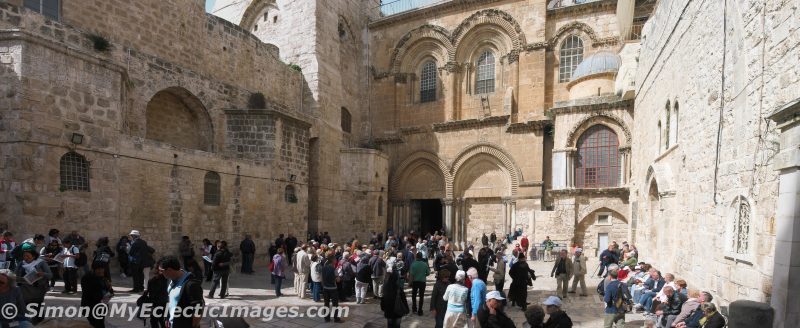Where Christianity’s Greatest Despair and Its Brightest Hope Meet.
Kneeling in front of the large flat stone of limestone marble, my fingertips tentatively touched the smooth, cool surface. It was not the original anointing stone where Joseph of Arimathea placed the body of Jesus Christ and prepared it for burial, but the picture in my mind surely matched the scene portrayed in the mosaic behind the stone. My very presence at the entrance to Christianity’s holiest site was a most powerful WOW!
My first experience with the Church of the Holy Sepulcher was that of a cynical, sulky 21-year-old. Just graduated from college in 1972, I had nothing but distain for anything to do with religion. During a three-week visit to the country of my birth that summer, I persuaded my mother and uncle – who lived in Jerusalem – to go into the Old City to see the Wailing Wall and then walk the 14 stations of the Cross (Via Dolorosa), so I could tell my friends back in Montreal I’d been there. Now, more than 4 decades later, it was an entirely different me standing where Christ was crucified, buried and resurrected.
The Wailing Wall had changed, as well. Security was tight and highly visible. The Western Wall of the Second Temple of Jerusalem had been excavated, and visitors could now descend, via an informative and moving tunnel tour, to marvel at the discoveries of the temple’s glory days that even today are still in the making.
Emerging from the enthralling experience in the tunnel, Simon, my cousin, Otto and I made our way through the ancient narrow streets of the Christian Quarter to the Church of the Holy Sepulcher. This time, I allowed my mind to open to the travesty and triumph millions of Christians believe had taken place on this site.

Another View of the Anointing Stone in the Church of the Holy Sepulcher (©simon@myeclecticimages.com)
It is alleged that in the 2nd century, Roman emperor Hadrian ordered a temple be built to honor Venus – the goddess, not the tennis star. His primary motive may well have been to cover up the cave where Jesus had been buried. Hidden agenda? Cover-up? That Hadrian guy was a politician to the core.
Somewhere around 325/326, Constantine the Great, the first Christian emperor, replaced Hadrian’s temple with a church. It was during this construction that the original cross and tomb were discovered.
Constantine’s church was in fact two adjoined churches over the sites of the crucifixion and burial of Jesus respectively. Consecration took place on September 13, 335.
But the ensuing centuries were anything but kind to the great church. Fires, earthquakes, desecration, neglect and near total destruction in 1009, at the hands of the “mad” Fatimid caliph Hakim took a heavy toll.
The church experienced a resurrection of its own in 1099, when the knights of the First Crusade captured Jerusalem. Over time, the Crusaders rebuilt the church in the Romanesque style that is the Church of the Holy Sepulcher we see today..
During the time these Crusaders occupied Jerusalem, three primary custodians of the church, were appointed: the Greek Orthodox, Armenian Apostolic and Roman Catholic churches. The Coptic Orthodox, Ethiopian Orthodox and Syrian Orthodox churches were added to the stew in the 19th century, but held lesser responsibilities.
I call it a ‘stew’ because it is rare that these entities, who supposedly believe in the same things, can agree on anything. Each has its own chapel in the church complex, and rituals and times of worship in common areas, are strictly regulated to insure fairness.
A ladder leaning against a window frame has been in the same place since the early 19th century, because no one could agree on who’s responsibility it was to put it away. And it took until 1959 for the three major custodians to manage to agree on a major plan to renovate the church.

The Rooftop of the Armenian Church as Part the Church of the Holy Sepulcher (©simon@myeclecticimages.com)
Sadly, there was far too little time to take in all the history, legends, historical events and quirks of the church of the Holy Sepulcher. I want to return at least one more time, because I feel there are more discoveries to be made in this complicated structure. And there is no doubt that the next experience will WOW me as never before.






